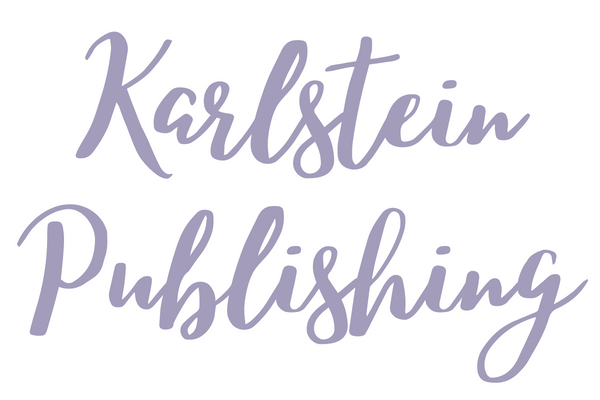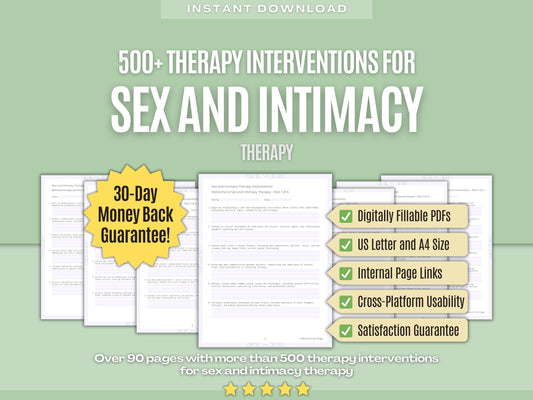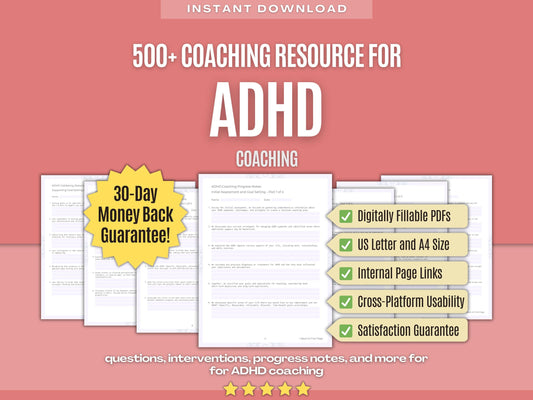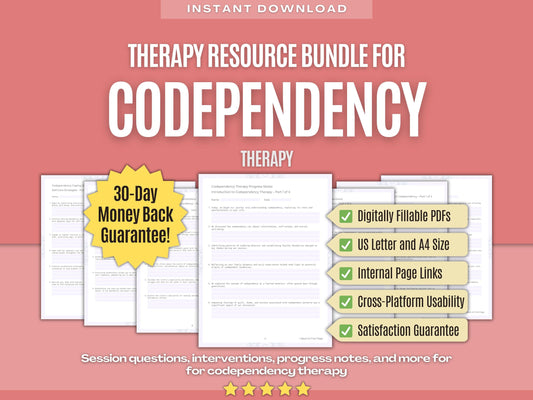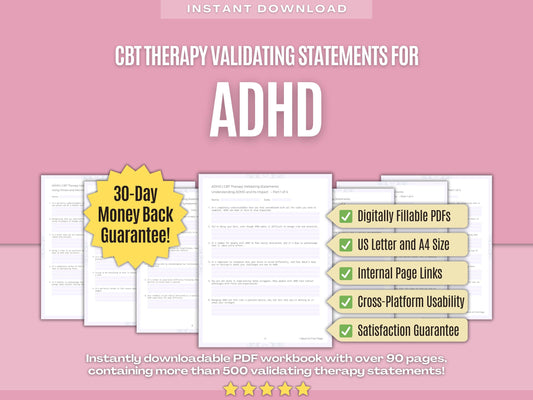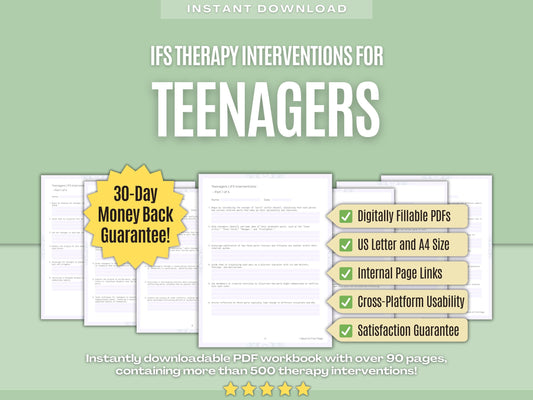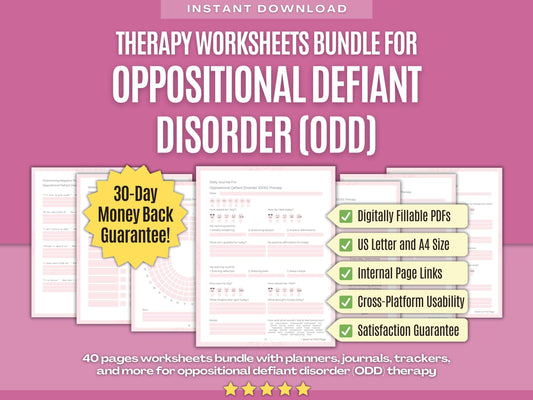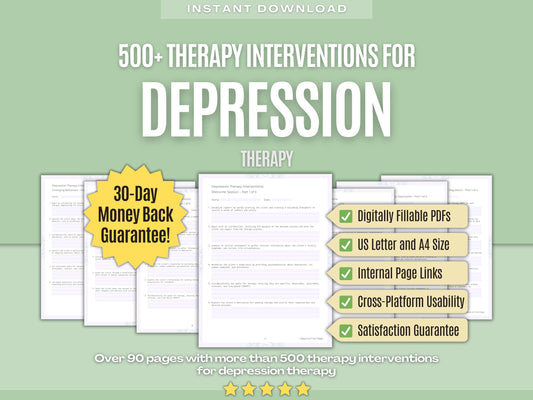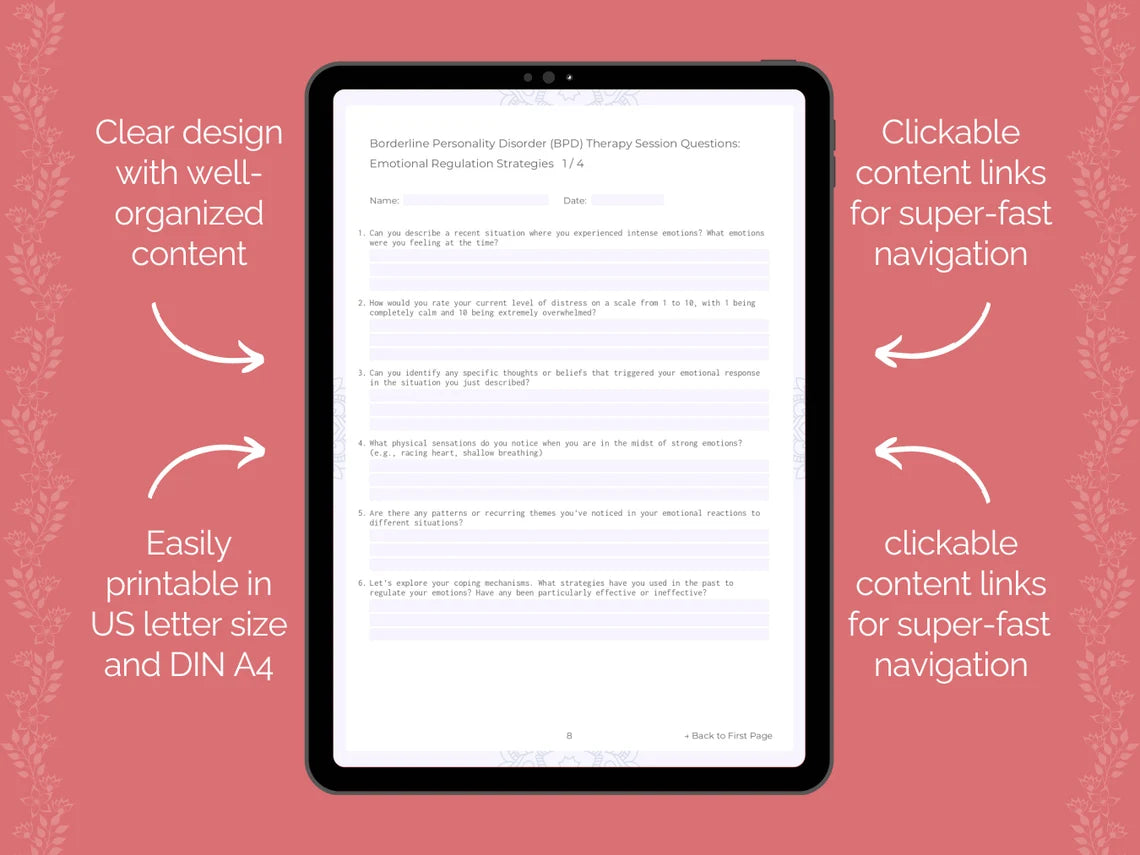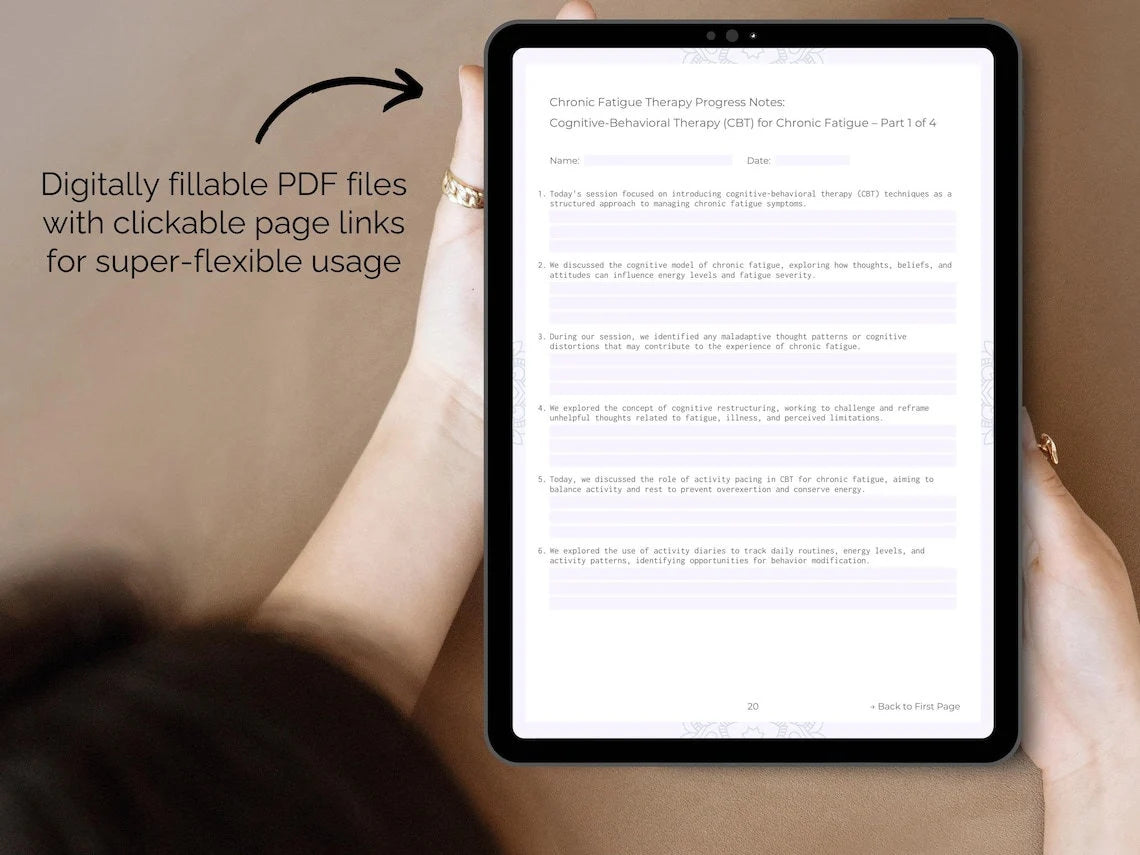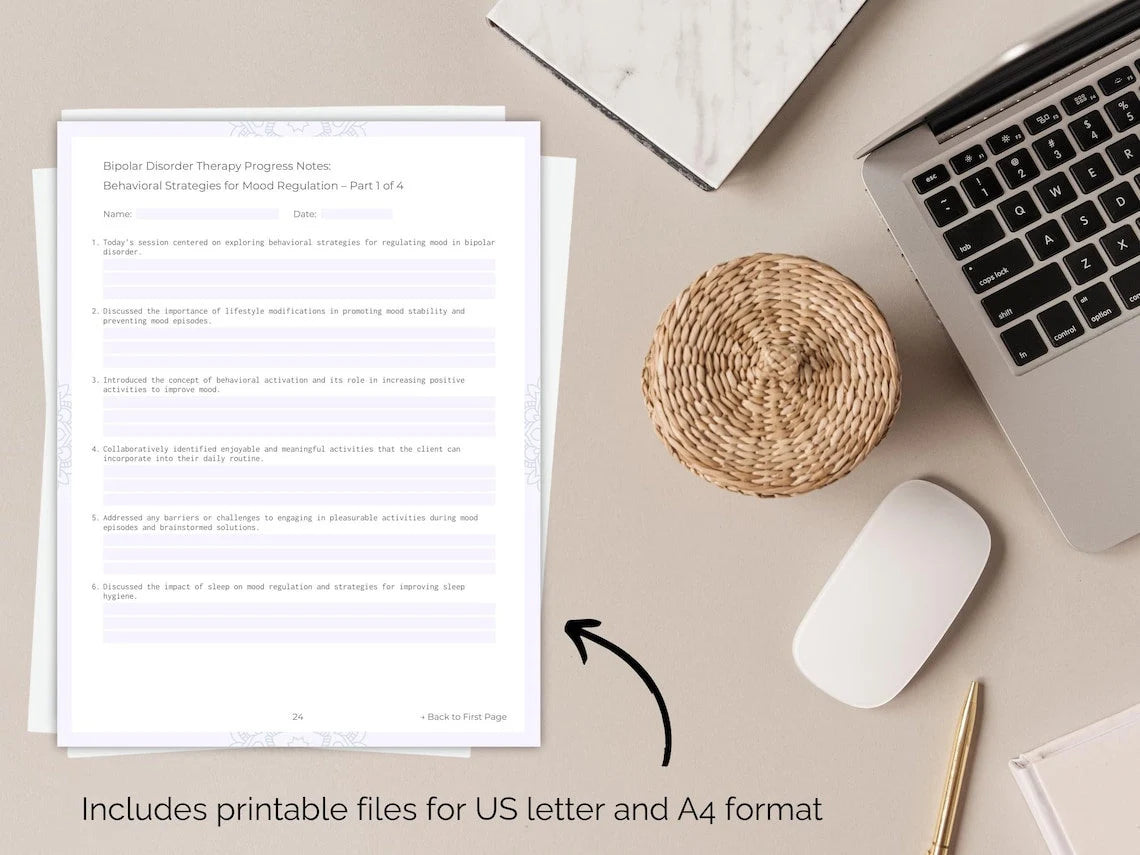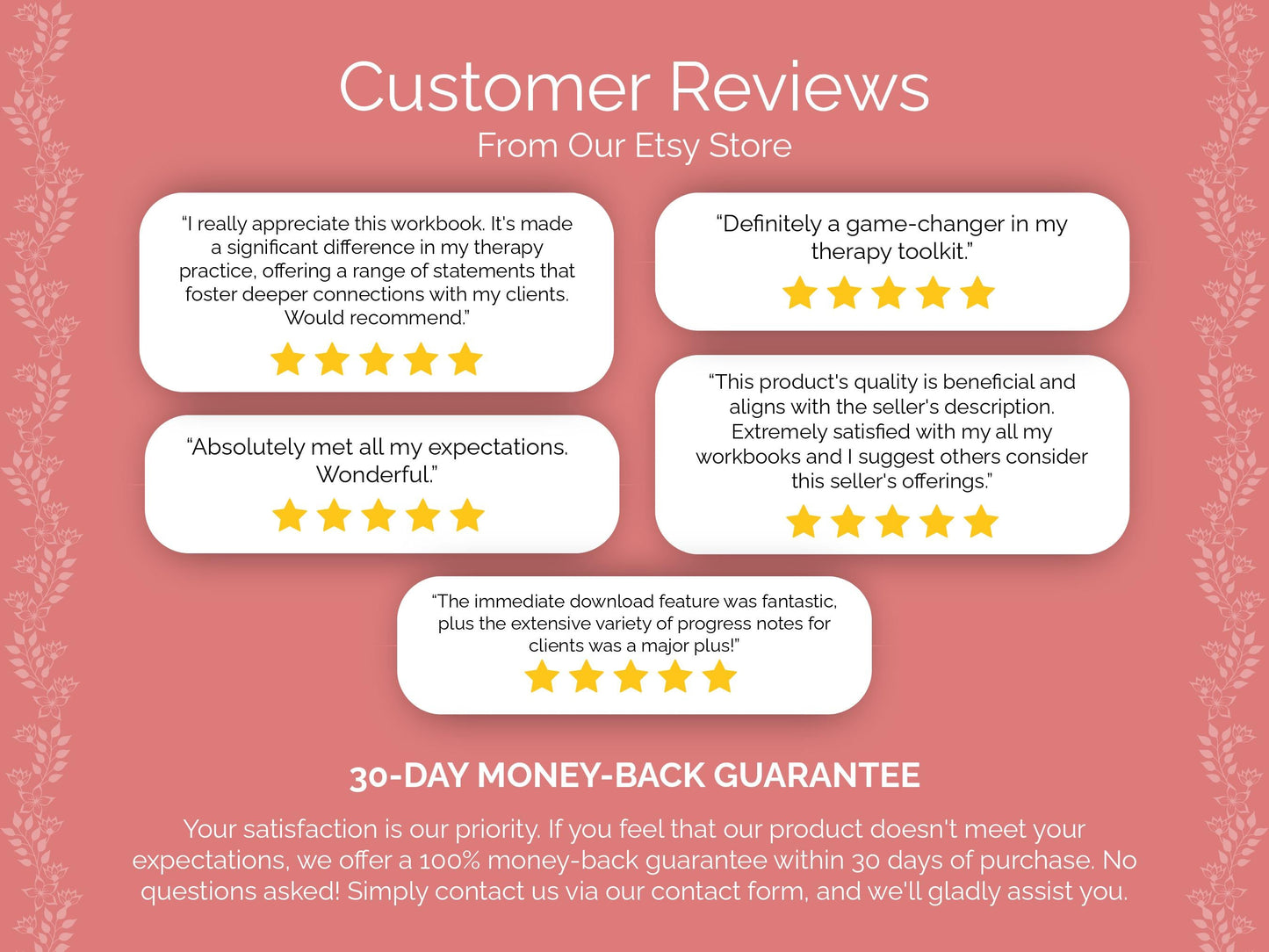Elevate Your Therapy and Guide Your Clients to Inner Healing with Our Stress and Anxiety Therapy Interventions! ✨
1. Beginning of Therapy
- Start by establishing a safe and confidential space where the client feels comfortable expressing themselves without fear of judgment or criticism.
- Develop a strong therapeutic alliance by demonstrating empathy, authenticity, and unconditional positive regard towards the client.
- Educate the client about the physiological and psychological effects of stress and anxiety, empowering them with knowledge to better manage their symptoms.
- Collaboratively set therapy goals that are specific, measurable, achievable, relevant, and time-bound (SMART), ensuring they align with the client's values and priorities.
- Introduce relaxation techniques such as deep breathing, progressive muscle relaxation, or guided imagery to help the client regulate their stress response.
- Encourage the client to keep a journal to track their thoughts, emotions, and triggers related to stress and anxiety, promoting self-awareness and reflection.
- Assess the client's lifestyle factors including sleep, nutrition, exercise, and substance use, and provide psychoeducation on the importance of self-care practices.
- Use cognitive-behavioral techniques such as cognitive restructuring and thought challenging to help the client identify and challenge maladaptive thought patterns.
- Collaboratively develop a coping skills toolbox with the client, including strategies such as problem-solving, assertiveness training, and time management.
- Use psychoeducation to teach the client about the mind-body connection and how stress can manifest physically, emotionally, and behaviorally.
- Assess the client's level of self-compassion and encourage them to cultivate a kind and nurturing attitude towards themselves.
2. Stress and Anxiety Psychoeducation
- Begin by explaining the nature of stress and anxiety, defining these terms as the body's natural response to perceived threats or challenges.
- Discuss the evolutionary purpose of stress, highlighting its role in promoting survival and enhancing performance in threatening situations.
- Introduce the concept of anxiety as a heightened state of worry, apprehension, or fear in response to perceived threats or uncertainty.
- Discuss common triggers of stress and anxiety, including environmental stressors, interpersonal conflicts, work or academic pressures, and life transitions.
- Provide psychoeducation on the cognitive components of stress and anxiety, including maladaptive thinking patterns such as catastrophizing, black-and-white thinking, and overgeneralization.
- Discuss the biopsychosocial model of stress, which recognizes the interaction between biological, psychological, and social factors in shaping individual experiences of stress and anxiety.
- Discuss the psychological consequences of chronic stress and anxiety, including mood disorders such as depression, generalized anxiety disorder, and post-traumatic stress disorder (PTSD).
- Discuss the importance of self-care practices in managing stress and anxiety, including regular exercise, healthy nutrition, adequate sleep, and relaxation activities.
- Address common misconceptions about stress and anxiety, such as the belief that stress is always harmful or that anxiety is a sign of weakness.
- Normalize seeking help for stress and anxiety, emphasizing that therapy is a proactive step towards improving well-being and coping skills.
- Encourage the client to monitor their stress and anxiety levels using self-assessment tools or diaries, fostering self-awareness and accountability.
3. Mindfulness-Based Interventions
- Begin by explaining the concept of mindfulness as the practice of paying attention to the present moment with openness, curiosity, and acceptance.
- Discuss the benefits of mindfulness-based interventions for reducing stress and anxiety, improving mood, enhancing self-awareness, and promoting overall well-being.
- Guide the client through mindfulness practices, encouraging them to observe their thoughts, emotions, bodily sensations, and external surroundings without judgment or attachment.
- Encourage the client to cultivate a beginner's mind, approaching each moment with a sense of openness, curiosity, and non-striving.
- Explore the connection between mindfulness and emotional regulation, teaching the client how to observe and accept their emotions without becoming overwhelmed by them.
- Explore the relationship between mindfulness and cognitive restructuring, teaching the client how to challenge maladaptive thought patterns and cultivate a more balanced perspective.
- Introduce informal mindfulness practices that can be integrated into daily life, such as mindful eating, walking, or listening, to help the client cultivate mindfulness in everyday activities.
- Discuss the neurobiological effects of mindfulness on the brain, highlighting research demonstrating changes in brain structure and function associated with regular mindfulness practice.
- Provide psychoeducation on the role of mindfulness in preventing relapse and maintaining long-term well-being, emphasizing the importance of ongoing practice and self-care.
- Discuss the benefits of mindfulness-based interventions in group settings, such as mindfulness-based stress reduction (MBSR) or mindfulness-based cognitive therapy (MBCT), for peer support and shared learning experiences.
- Introduce advanced mindfulness practices such as loving-kindness meditation, compassion meditation, or gratitude meditation to deepen the client's mindfulness skills and cultivate positive emotions.
4. Dialectical Behavior Therapy (DBT) for Stress and Anxiety
- Begin by introducing the foundational principles of Dialectical Behavior Therapy (DBT), emphasizing the balance between acceptance and change.
- Discuss the four primary modules of DBT - mindfulness, distress tolerance, emotion regulation, and interpersonal effectiveness - as tools for managing stress and anxiety.
- Guide the client through mindfulness exercises such as mindful breathing, body scan, and mindful walking to cultivate a greater sense of calm and groundedness.
- Teach the client emotion regulation skills to identify, label, and modulate their emotions in healthy and adaptive ways.
- Encourage the client to develop a personalized emotion regulation toolkit with coping strategies that resonate with their individual needs and preferences.
- Address the concept of dialectics and the idea that seemingly contradictory truths can coexist, encouraging the client to find synthesis between acceptance and change in their approach to stress and anxiety.
- Teach the client interpersonal effectiveness techniques such as DEAR MAN, FAST, and GIVE to navigate interpersonal interactions with greater skill and confidence.
- Explore the impact of invalidating environments on stress and anxiety, providing psychoeducation on how to create and maintain validating relationships and settings.
- Encourage the client to practice self-compassion and self-care as ways of nurturing themselves and managing stress in healthy ways.
- Teach the client problem-solving skills to address practical challenges and stressors in their environment, empowering them to take proactive steps towards resolution.
- Address barriers to mindfulness practice such as resistance, avoidance, or skepticism, helping the client explore and overcome obstacles to engagement.
5. Interpersonal Therapy (IPT) for Stress and Anxiety
- Begin by introducing the core principles of Interpersonal Therapy (IPT), which focuses on the relationship between interpersonal problems and psychological symptoms such as stress and anxiety.
- Explore the client's interpersonal difficulties and conflicts, identifying specific patterns of interaction that contribute to distress in relationships.
- Address interpersonal disputes or conflicts that may be sources of stress and anxiety, helping the client communicate assertively and resolve conflicts in a constructive manner.
- Explore the impact of significant life changes or transitions on the client's stress and anxiety, providing support and coping strategies to navigate these challenges.
- Implement role-playing exercises to help the client practice assertive communication and problem-solving skills in simulated interpersonal situations.
- Explore the client's attachment style and its impact on their interpersonal relationships and coping strategies, providing psychoeducation and support for developing secure attachment patterns.
- Discuss the role of social comparison and self-esteem in interpersonal relationships, helping the client cultivate a realistic and compassionate view of themselves in relation to others.
- Address role transitions such as career changes, parenthood, or retirement as sources of stress and anxiety, helping the client navigate these transitions and adapt to new roles.
- Explore the client's relationship with authority figures such as parents, teachers, or supervisors, addressing any unresolved conflicts or power dynamics that contribute to stress and anxiety.
- Address the impact of social media and technology on interpersonal relationships and stress levels, helping the client establish healthy boundaries and balance online and offline interactions.
- Provide resources and recommendations for further reading or online tools that the client can use to deepen their understanding and practice of IPT principles outside of therapy sessions.
6. Emotion-Focused Therapy (EFT) for Stress and Anxiety
- Encourage clients to identify and label their emotions accurately, fostering self-awareness and emotional intelligence.
- Explore the origins of clients' stress and anxiety, including past experiences and underlying beliefs, to gain insight into triggers and patterns.
- Use guided imagery exercises to help clients visualize themselves coping with stress and anxiety effectively, promoting a sense of empowerment.
- Implement relaxation techniques such as progressive muscle relaxation to reduce physical tension and promote a sense of calmness.
- Incorporate expressive arts therapies, such as journaling or drawing, as creative outlets for processing emotions and reducing stress.
- Introduce problem-solving strategies to help clients address sources of stress in their lives proactively and regain a sense of control.
- Encourage social support by helping clients strengthen their relationships and establish a network of trusted individuals they can turn to during difficult times.
- Utilize role-playing exercises to help clients practice assertiveness and boundary-setting skills in challenging situations.
- Collaboratively develop personalized coping strategies tailored to clients' unique strengths, preferences, and goals.
- Use metaphorical techniques to help clients externalize their emotions and gain new perspectives on their experiences.
- Guide clients in identifying and challenging core beliefs about themselves and the world that contribute to their stress and anxiety.
7. Psychodynamic Therapy for Stress and Anxiety
- Begin by establishing a strong therapeutic alliance with clients, emphasizing empathy, trust, and confidentiality as foundational elements of psychodynamic therapy.
- Use exploration of clients' childhood memories and experiences to uncover unconscious conflicts and patterns of relating that may be influencing their present-day stress and anxiety.
- Utilize free association techniques to help clients access unconscious thoughts and feelings related to their stress and anxiety, fostering self-awareness and insight.
- Facilitate exploration of clients' emotional conflicts and ambivalence, recognizing that unresolved inner tensions can contribute to feelings of stress and anxiety.
- Use interpretation to help clients understand the deeper meaning behind their thoughts, feelings, and behaviors, promoting insight and self-reflection.
- Encourage clients to explore their sense of identity and self-concept, recognizing that conflicts related to identity can contribute to stress and anxiety.
- Use the therapeutic relationship as a vehicle for exploration and healing, recognizing that the dynamics between therapist and client can shed light on unconscious processes.
- Encourage clients to explore their fantasies and daydreams, recognizing these as manifestations of unconscious desires and fears.
- Explore clients' patterns of self-sabotage and avoidance, recognizing that these behaviors may serve as unconscious defenses against anxiety-provoking thoughts or feelings.
- Encourage clients to explore their internalized beliefs and expectations, recognizing that these may contribute to feelings of inadequacy or insecurity.
- Facilitate exploration of clients' internal conflicts and dilemmas, recognizing that inner tensions can contribute to feelings of stress and anxiety.
8. Music Therapy for Stress and Anxiety
- Begin by introducing clients to various types of music and inviting them to explore how different genres, rhythms, and melodies affect their mood and emotions.
- Encourage clients to create personalized playlists of music that they find soothing or uplifting, providing them with a readily accessible tool for managing their emotions.
- Use lyric analysis to help clients explore the themes and messages in songs that resonate with their experiences of stress and anxiety, providing a framework for self-reflection and insight.
- Use improvisation techniques with musical instruments or voice to help clients express and release emotions in a non-verbal way, providing a cathartic outlet for emotional expression.
- Use guided imagery exercises with instrumental music to help clients visualize calming scenes or imaginary landscapes, promoting relaxation and stress reduction.
- Facilitate group music therapy sessions where clients can engage in collaborative music-making activities, fostering a sense of camaraderie and mutual support.
- Use music-assisted relaxation techniques, such as progressive muscle relaxation or guided imagery, to help clients deepen their relaxation response and reduce physiological arousal.
- Encourage clients to engage in expressive movement activities with music, such as dancing or spontaneous movement, as a way of releasing tension and promoting emotional expression.
- Explore clients' experiences of music-induced trance states or altered states of consciousness, recognizing the potential for music to facilitate spiritual and transcendent experiences.
- Encourage clients to engage in active listening exercises with music that challenges their emotional responses or invites them to explore unfamiliar genres or styles.
- Facilitate music-assisted relaxation exercises with live or recorded music, incorporating elements of breathwork, visualization, and progressive muscle relaxation to promote deep relaxation and stress reduction.
9. Therapy Session Wrap-Up
- Reflect on the progress made during the session, highlighting any insights, breakthroughs, or positive changes that occurred.
- Encourage clients to share their thoughts and feelings about the session, providing a safe space for them to express themselves openly and honestly.
- Validate clients' efforts and accomplishments, acknowledging the courage and resilience it takes to engage in therapy and work towards personal growth.
- Explore any resistance or ambivalence towards therapy or specific interventions, collaboratively problem-solving and adjusting the approach as needed.
- Discuss potential barriers or obstacles to progress, such as logistical challenges or negative thought patterns, and develop strategies for overcoming them.
- Validate any emotions that emerged during the session, offering empathy and understanding as clients navigate their inner experiences.
- Collaboratively set goals for the next session, ensuring they are specific, achievable, and aligned with the client's values and aspirations.
- Offer reassurance and support for any difficult emotions or challenges that may arise between sessions, reminding clients that they are not alone in their journey.
- Integrate mindfulness or grounding exercises to help clients transition out of the therapeutic space and back into their daily lives.
- Reinforce the therapeutic alliance by expressing appreciation for the client's trust and willingness to engage in the therapeutic process.
- Provide resources or referrals for additional support outside of therapy, such as support groups, workshops, or community resources.
10. Concluding Therapy Meeting
- Reflect on the client's progress throughout the therapy journey, acknowledging the milestones and achievements they have made.
- Review the goals set at the beginning of therapy, discussing the progress made towards each goal and celebrating any successes.
- Discuss the client's experience of the therapeutic relationship, inviting feedback and reflections on the effectiveness of the therapeutic approach.
- Offer closure and closure rituals, such as writing a goodbye letter or creating a memory keepsake, to help the client process the ending of therapy.
- Discuss the importance of self-care and ongoing support, encouraging the client to continue practicing self-care techniques and seeking support from loved ones.
- Reinforce the client's autonomy and resilience, reminding them of their ability to cope with stress and anxiety using the skills they have learned in therapy.
- Discuss any lingering questions or concerns the client may have about concluding therapy, providing clarity and reassurance as needed.
- Encourage the client to reflect on their personal growth and insights gained during therapy, fostering a sense of self-awareness and empowerment.
- Offer a summary of the client's strengths and resilience, emphasizing their capacity for growth and transformation.
- Validate any fears or anxieties the client may have about ending therapy, providing reassurance and support as they navigate this transition.
- Collaboratively create a plan for managing potential stressors or triggers post-therapy, identifying coping strategies and resources to support the client's well-being.
We hope that our therapy interventions for Stress and Anxiety therapy will help you to elevate your therapy practice and guide your clients to inner healing! Do you need more therapy interventions for Stress and Anxiety therapy? Find them all in our Digital Workbook! Or do you have any questions or suggestions for us? Please feel free to contact us at any time!
